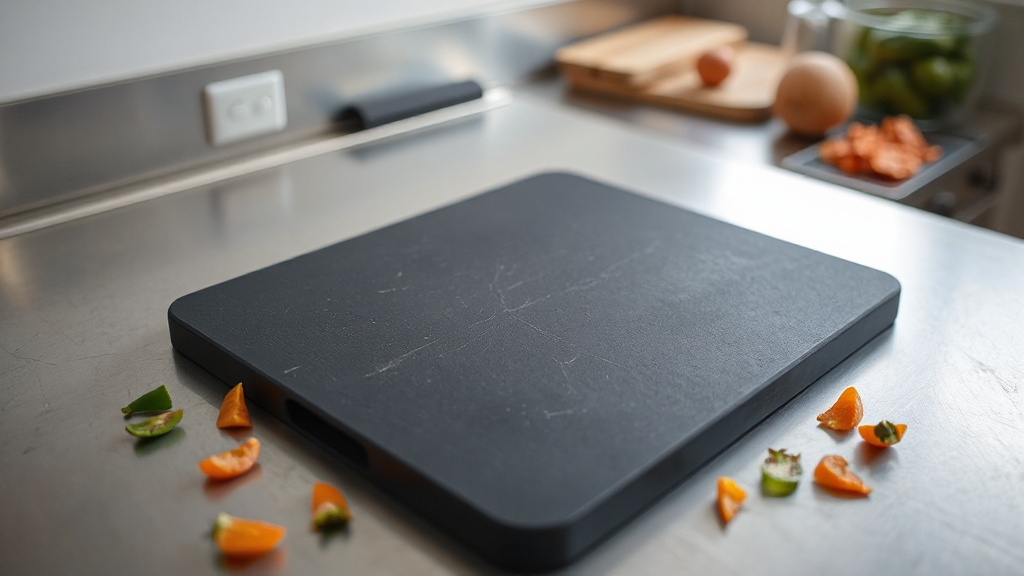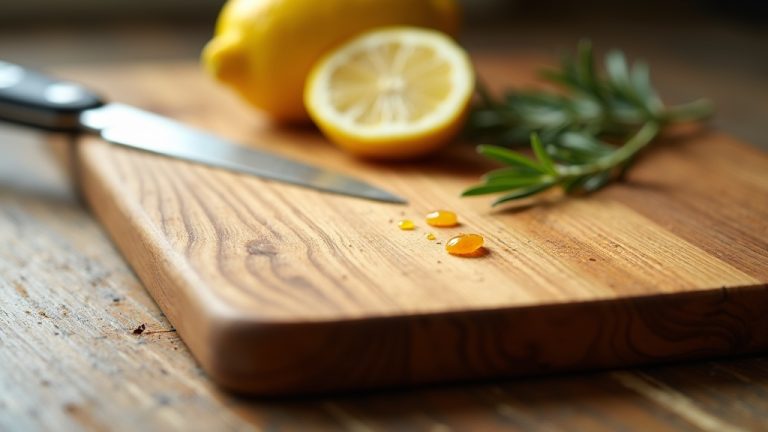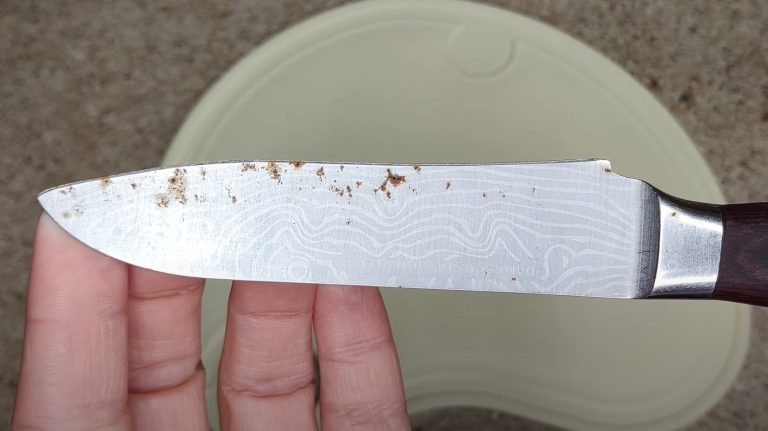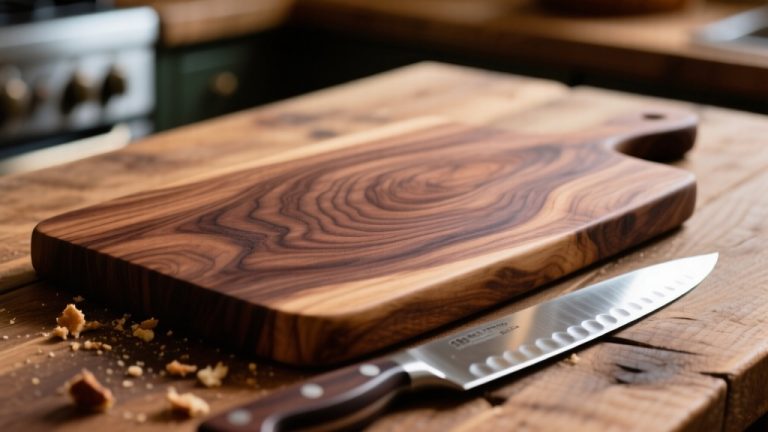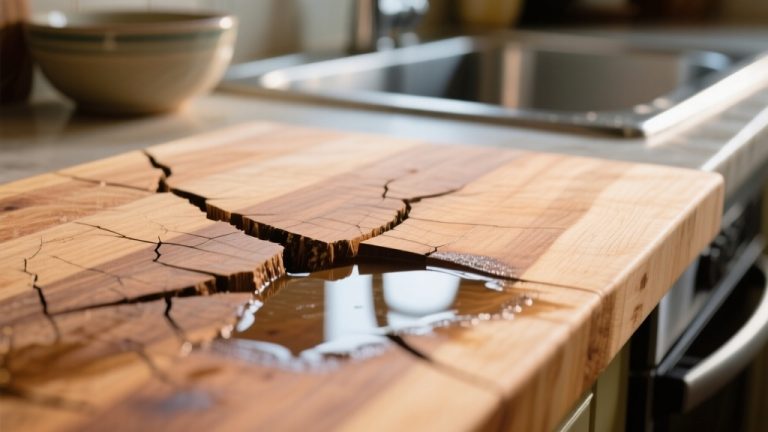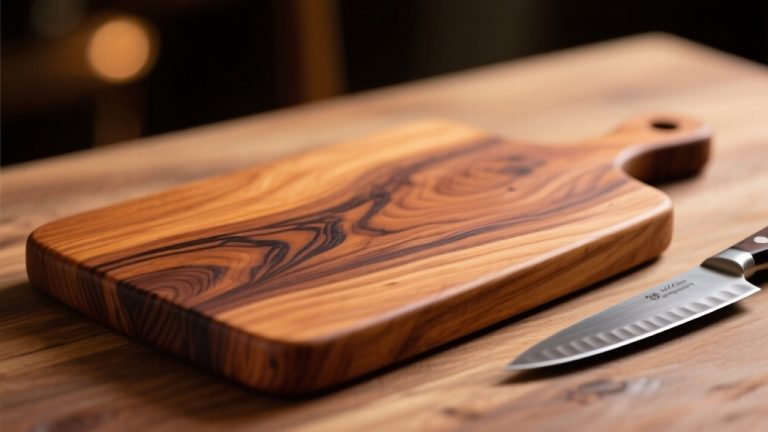Are Rubber Cutting Boards Toxic: From Kitchen to Health
You’re likely wondering if rubber cutting boards are toxic, and the evidence suggests they’re generally safe when made from high-quality, food-safe materials.
Research shows no significant toxicity risks, but low-quality rubber might contain harmful additives like BPA. Always check for FDA compliance or regional certifications to verify safety.
Their non-porous surface also resists bacterial growth, reducing contamination risks. Stick around to uncover more insights on their performance and safety compared to other materials.
Key Takeaways
- Rubber cutting boards may contain toxic additives like BPA if low-quality, posing potential health risks.
- High-quality rubber boards comply with FDA regulations, ensuring non-toxic materials for food safety.
- Limited research exists on microplastic shedding from rubber, making toxicity risks unclear.
- Chemical leaching or off-gassing can occur in poor-quality rubber, unlike certified products.
- Long-term health effects of rubber’s chemical additives remain undocumented and require further study.
Material Breakdown of Rubber Cutting Boards
When you examine the material composition of rubber cutting boards, you’ll find a synthetic rubber base often blended with wooden powder additives to enhance texture. This combination creates a non-porous structure that inhibits bacterial absorption, outperforming wood or plastic.
You’ll also notice some variants include phenolic resin binders for added strength in composite designs. As a notable example, the Asahi Rubber Cutting Board, weighing 15lb, exemplifies this durable construction weighing 15lb.
Analyze further, and you’ll see the dense molecular structure reduces knife edge degradation compared to plastic. These boards resist heat up to 212°F, though prolonged exposure risks warping.
Opt for high-quality options to guarantee stability and durability. With a heavier build than lightweight plastic, they offer superior stability during use.
Microplastic Concerns With Rubber Surfaces
As you assess rubber cutting boards, consider the limited data on microplastic shedding levels, since research primarily targets plastic materials like polyethylene, not rubber.
You’ll also need to examine particle size analysis, as the dimensions and shapes of any released microplastics could influence their potential impact, though specific studies on rubber are scarce.
It’s important to note that microplastics are associated with health risks, including potential links to serious conditions as highlighted in recent studies.
Microplastic Shedding Levels
Countless tiny particles could be making their way into your food with every slice on a rubber cutting board, yet specific research on microplastic shedding from rubber surfaces remains frustratingly absent.
You’re left guessing about risks since no direct studies exist, unlike plastic boards, which shed 1-15 microplastics per cut, totaling 7.4-50.7 grams yearly with daily use.
Know that knife grooves worsen shedding across flexible materials, and rubber’s elasticity might reduce scarring compared to rigid plastics. Additionally, the type of food being cut, such as harder vegetables, could influence the amount of particle release harder vegetables influence.
Still, without data, you can’t confirm safety. Consider usage patterns—horizontal slicing sheds less than dicing, and worn boards release more particles.
Particle Size Analysis
Several factors come into play when analyzing particle size from rubber cutting boards, especially since research on their microplastic shedding remains scarce.
You’ll notice that unlike plastic boards, which are well-documented for releasing microplastics, rubber surfaces lack extensive study. The texture of the board and your usage patterns—like frequent, heavy cutting—can influence particle release.
Moreover, detecting these tiny particles demands advanced techniques, as they can move through food or water during prep.
You should know that the environmental impact of rubber particles isn’t as understood compared to other materials. Until more research quantifies particle shedding from rubber, you’re left with gaps in data. Additionally, rubber boards may develop grooves over time, potentially increasing particle release rates.
Toxicity Risk Assessment
While research on rubber cutting boards remains limited, you should be aware that their potential for microplastic shedding and toxicity risks isn’t well-documented compared to plastic surfaces.
Unlike plastic boards, which release significant microplastics during chopping—ranging from 7.4 to 49.5 grams annually—rubber’s impact remains unclear.
Though considered safer if made from non-toxic materials, there’s no conclusive data on chemical additives or long-term health effects with rubber.
Recent studies on other materials, like wood, show they can release tens of millions of microparticles annually, raising similar concerns for untested surfaces like rubber.
Consider these critical points about microplastic risks:
- Plastic Comparison: Plastic boards contribute to ingestion risks, potentially entering your bloodstream.
- Unknown Rubber Effects: Rubber’s microplastic release and toxicity aren’t studied extensively.
- Health Uncertainty: Long-term impacts of microplastics, even from other materials, remain under investigation.
Chemical Safety in Rubber Board Production
As you explore the safety of rubber cutting boards, it’s critical to understand the chemical composition involved in their production. Manufacturers often use high-quality rubber or synthetic materials, but some may include toxic additives like BPA.
You must check if the board complies with safety standards and regulatory bodies to avoid harmful chemicals. Look for certifications from organizations like ANSI or ISO, ensuring the product meets strict protocols.
Be aware that low-quality rubber can leach chemicals or off-gas, posing health risks. Always review product labels and material disclosures for transparency. Additionally, rubber boards can be durable and knife-friendly when free from toxic additives.
Hygiene Benefits of Rubber for Food Prep
When you choose a rubber cutting board, you’re opting for a surface that naturally resists bacterial growth due to its non-porous structure, considerably lowering contamination risks compared to plastic or wood.
You’ll also find that its self-sanitizing properties and resistance to mold make it a standout for maintaining a clean prep area, even in humid conditions.
Making informed choices about kitchen tools, like opting for rubber cutting boards, aligns with the importance of food safety practices emphasized in healthy eating guidelines.
Bacterial Growth Resistance
Consider these critical points:
- *Rubber’s density*: Less porous than wood, possibly limiting deep bacterial penetration.
- *Surface texture*: Smoother surfaces may harbor accessible bacteria, unlike textured materials.
- *Hygiene priority*: Material matters less than consistent, proper handling to avoid cross-contamination.
- *Sanitation ease*: Rubber cutting boards are often dishwasher-safe, enhancing cleanliness.
Easy Sanitization Process
While exploring the hygiene benefits of rubber cutting boards, you’ll find that their easy sanitization process stands out as a key advantage.
You can clean them effectively by scraping off food particles and washing with warm soapy water. For stubborn residues, cover the board with saturated towels overnight to loosen debris.
Sanitizing with diluted bleach or other approved solutions like iodine guarantees disinfection, though you must follow instructions to avoid material interactions. Proper cleaning and sanitizing are essential to prevent the growth of pathogens on the board’s surface prevent pathogen growth.
Unlike plastic or stainless steel, many rubber boards aren’t dishwasher-safe, so check compatibility before using thermal methods. This ability to sanitize without damage is crucial for hygiene, but always inspect your board’s condition and select the right cleaning method based on its specific rubber type.
Regulatory Standards for Rubber Boards
As you explore the safety of rubber cutting boards, it’s clear that regulatory standards play a critical role in guaranteeing their suitability for food contact.
You’re wise to reflect on how these boards meet stringent guidelines like FDA compliance, which mandates the use of Generally Recognized as Safe (GRAS) substances.
In the U.S., manufacturers must verify safety through rigorous testing, while in Japan, certifications like SIAA add antimicrobial assurance.
Additionally, rubber cutting boards are often favored for their non-porous surface, which resists bacterial growth and ensures safer food preparation.
Check these key regulatory highlights:
- FDA Compliance: Guarantees materials are non-toxic for food prep.
- Regional Standards: Certifications vary, like SIAA in Japan for safety.
- Manufacturer Testing: Confirms material purity and compliance before market release.
Performance Comparison Across Board Types
Moving from regulatory standards to practical use, let’s examine how rubber cutting boards stack up against other materials like wood and plastic with respect to performance. You’ll find rubber boards, made from synthetic polyvinyl acetate, excel in durability and knife protection.
They don’t warp like wood and offer better tactile feedback than plastic. Rubber’s softness preserves knife sharpness, especially for Japanese or high-carbon steel blades, while its density guarantees stability.
Additionally, rubber’s non-porous nature ensures superior bacteria resistance, making it a hygienic choice for kitchen prep. In comparison, bamboo cutting boards also offer notable benefits with their natural antimicrobial properties, providing an eco-friendly and hygienic alternative to synthetic materials.
Check this comparison:
| Feature | Rubber vs. Wood vs. Plastic |
|---|---|
| Durability | Rubber: High; Wood: Moderate; Plastic: High |
| Knife Protection | Rubber: Excellent; Wood: Good; Plastic: Fair |
| Maintenance | Rubber: Low; Wood: High; Plastic: Low |
Practical Considerations for Rubber Use
Considering the practical aspects of rubber cutting boards, you’ll find they offer distinct advantages in durability and maintenance compared to other materials.
They’re more resistant to cuts and scratches, don’t require oiling like wooden boards, and are easier to clean and sanitize.
However, their limited availability might make sourcing one a challenge, and pricing varies based on quality and brand.
Here’s why you should weigh these factors:
- Durability: Rubber withstands wear better than many alternatives, extending its lifespan.
- Maintenance: You’ll spend less time on upkeep with no need for special treatments.
- Availability: Since they’re less common, you might need to search specialty stores.
Additionally, rubber cutting boards can help prevent cross-contamination by providing a non-porous surface that resists bacterial growth non-porous surface.
Frequently Asked Questions
Can Rubber Cutting Boards Cause Allergic Reactions?
Hey, you might wonder if rubber cutting boards can trigger allergic reactions. Evidence suggests they could, especially if you’re sensitive to latex, due to potential material similarities.
Though not commonly reported, reactions are possible depending on the board’s composition. Research is limited, so you’ve gotta be cautious.
Clean your board thoroughly to avoid cross-contamination, and if you’ve got latex allergies, consider switching to a different material for safety.
Are Rubber Boards Safe for Children’S Food Prep?
When considering if rubber cutting boards are safe for children’s food prep, you’ll find they’re a solid choice. Their non-slip surface prevents accidents, and lightweight design makes handling easy for kids.
Opt for food-grade natural rubber to guarantee safety, avoiding synthetic options with harmful chemicals. Check for rounded edges to minimize injury risks.
With proper care, like hand-washing, you’re guaranteeing a secure, durable tool for young chefs.
Do Rubber Boards Affect Food Taste or Smell?
Hey, let’s explore whether rubber cutting boards affect food taste or smell.
You’ll find that rubber boards are neutral, so they don’t impart flavors or odors to your meals. Unlike wood or some plastics, they lack pores to absorb tastes.
Their smooth surface prevents residue buildup, ensuring your food stays unaffected. Research shows they’re ideal for varied prep, keeping your dishes’ natural flavors intact.
How Do Rubber Boards Handle Extreme Cold Temperatures?
Did you know rubber cutting boards can endure temperatures as low as -30°C (-22°F)?
When you use them in extreme cold, expect reduced flexibility due to material contraction. This can make the rubber brittle over prolonged exposure, though structural damage isn’t likely.
The compression set worsens, impacting performance, but specialized materials can help. Keep an eye on conditions, and you’ll maintain their functionality even in freezing environments.
Are Rubber Boards Environmentally Friendly to Produce?
When considering if rubber boards are environmentally friendly to produce, you’ll find a mixed picture.
Natural rubber relies on latex harvesting, which can cause deforestation if not sustainably managed.
Synthetic options involve energy-intensive vulcanization and petrochemical byproducts.
You’re also facing high energy use and limited recyclability.
Though natural rubber’s carbon footprint might be lower than plastic’s, unsustainable practices and waste issues mean you can’t call production fully eco-friendly.
Safe, Strong, and Ready to Chop: Trust in Rubber
As you weigh your options, picture a rubber cutting board under your knife, its sturdy surface resisting deep cuts while safeguarding your food.
You’ve seen the evidence—rubber’s low microplastic risk, chemical safety under strict regulations, and hygiene perks.
Compared to other boards, it’s a reliable choice. So, don’t hesitate. Grab that rubber board, slice with confidence, and trust it’s a practical, safe ally in your kitchen’s daily battles.

